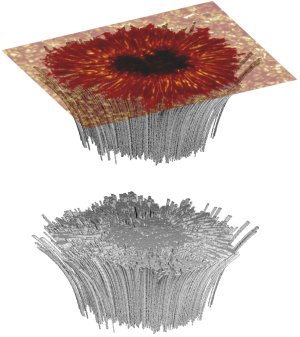 |
|
Fig. 1:
Top: Sunspot image made with the Swedish telescope, combined with a sketch
of the inferred 3-dimensional structure (schematic) underneath the spot.
The structure consists of a cluster of magnetic strands which continue down
into the interior of the Sun (see sketch in Fig. 2). Only the uppermost
part of this cluster is shown here and the continuation of the magnetic
field lines above the surface is also left out. When the surface layers are
stripped away (bottom panel), gaps in this cluster become visible. They
are mostly present in the penumbra (the filamentary outer part of the spot)
but gaps remain even in the dark umbra. [Schematic, in reality the gaps are
much narrower and more numerous.]
|
 |
 |
|
Fig. 2:
Vertical section through a sunspot and the convective envelope
(swirls) of the Sun. What is just a dark patch at the surface is part of a
magnetic field that continues above the surface of the Sun (dashed lines)
and into the interior.
|
|  |
What would a sunspot look like if one could see below the surface of
the Sun? The answer turns out to be rather clear if one looks
carefully enough at the surface itself, but the result is quite not
what one might have expected. The close look required for this has
been made possible by the new Swedish 1-meter Solar Telescope (SST) on
La Palma. Figure 1 show the answer, the result of a collaboration
between the Max Planck Institute for Astrophysics and the Institute
for Solar Physics of the Royal Swedish Academy of Sciences. What at
the surface looks like a compact magnetic patch turns out to be the
end of a looser cluster of magnetic strands underneath, similar to the
frayed end of a piece of rope. With this structure as a framework, a
whole range of old and new puzzling observations neatly fall into
place.
One of the oldest of these puzzles is the brightness of sunspots. The
strong magnetic field of a spot is known to suppress the transport of heat
from deeper layers to the surface, causing the spot to look dark. This
suppression is in fact so effective that the observed radiation from even
the darkest parts of spots is actually hard to explain.
In the tenuous visible layers of the Sun the magnetic field lines of a
sunspot fill up all available space, but below the surface they can be kept
apart by the gas pressure. The calculations now show that below the surface
the magnetic field is in all likelihood organized differently from above.
They show that the brighter streaks in the outer parts of the spot (the
so-called filaments) are just a reflection of narrow gaps free of magnetic
field, between bundles of strong field. This structure would become clear
if one could look only a bit deeper into the Sun. Through the gaps
radiation energy reaches the surface much more easily than through the
magnetic field itself.
Apart from the brightness of spots, the model explains the close connection
between penumbral filaments and bright 'dots' in the umbra as well as the
so-called 'dark cores' of penumbral filaments (recently discovered with the
SST), and makes predictions about the polarization of light from sunspots
that can be tested in the near future.
Henk Spruit,
Max-Planck-Institut für Astrophysik,
Göran Scharmer,
Institute for Solar Physics of the Royal Swedish Academy of
Sciences.
Publication:
 "Fine structure, magnetic field and heating of sunspot penumbrae"
, Astronomy and Astrophysics, in press
"Fine structure, magnetic field and heating of sunspot penumbrae"
, Astronomy and Astrophysics, in press
|
